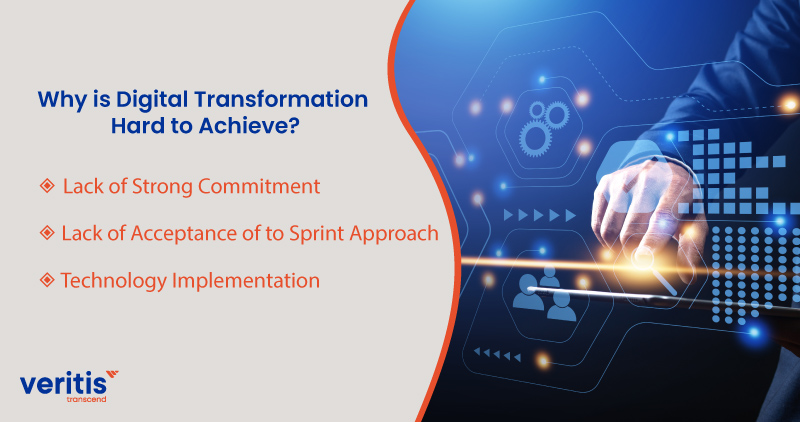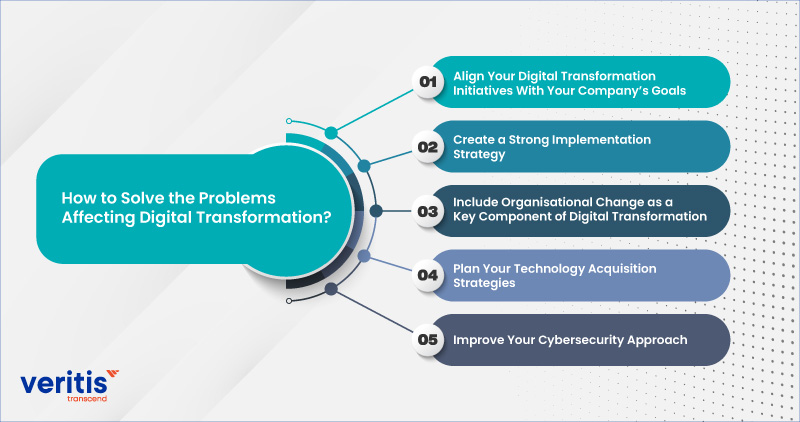
Digital Transformation (DX) is one transition that every firm in every industry is keen about today. The growing consumer preferences and increasing market competition have made digital transformation the need of the hour for every firm. Digital transformation solutions have transformed the way industry functions by bringing in an all-around change in the overall business culture.
Even though firms frequently still have a long way to go, digital transformation strategies are not a new need for company leaders. Using digital technologies and methods of working at scale is still challenging for many businesses. Another option is to foster a culture that values experimentation, change, and ongoing learning. Still, some businesses are considering complete makeovers but have not progressed from the planning stage.
How can businesses then accelerate their digital transformation services? The solution is to develop a vision for the future and gradually enhance the technology and human capacities that enable you to realize it.
Thanks to digital transformation solutions, your company has the chance to reinvent how your business is managed through new digital transformation strategies, processes, and tools. You must, however, overcome obstacles at every stage of the digital business transformation process.
The World Economic Forum predicts that digital transformation will have added USD 100 trillion to the global economy by 2025. Furthermore, platform-driven interactions are anticipated to enable almost two-thirds of the USD 100 trillion in potential value from digitization by 2025.
It is anticipated that digitally transformed businesses will account for USD 53.3 trillion, or more than half of the GDP in 2023. As a business leader, you must be aware that difficulties with digital transformation services are only sometimes directly tied to issues with technology or technical obstacles. They also incorporate organizational structures, human-centered challenges, and other non-tech aspects. Finding out which particular issues influence your company is the best method to deal with them.
Why is Digital Transformation Hard to Achieve?

The term “digital transformation” refers to an altogether new, inventive manner of carrying out a task that is essential to your organization, rather than simply referring to adopting new software, digital technologies, and more automated and efficient procedures than conventional business practices and processes.
While undertaking a digital business transformation program, organizations must consider all factors, including how employees will react to the change, how it will affect customer relations, the cost, how it will connect with corporate objectives, and so on. Digital transformations give businesses the power to move into the future and put them in a position to compete and expand into new markets.
All of that, however, is more said than done; according to statistics on digital transformation solutions, only 16% of teams believe their company’s digital transformation efforts have enhanced their performance or are sustainable, and 70% of all digital transformation programs fail due to employee resistance and a lack of management support.
Fatigue as a result of ‘continuous change’ is considered one of the key reasons behind such failures. Here, we will look into three major reasons that can lead to a digital transformation company’s failure:
1) Lack of Strong Commitment
Understanding and accepting a concept or vision is entirely different from committing to its implementation and supporting its journey.
Implementing digital transformation framework business transformation efforts successfully in the first phase and not continuing it to the further phases can break the continuity of the plan. Remember! Digital business transformation initiatives mean a massive change, not just in one step.
It should apply enterprise-wide and across cross-functional teams. Every stakeholder involved should consider the personal ownership of the initiative being rolled out and be able to support the case. There needs to be a collective vision acceptable across the chain, from the top-level executives to every stakeholder associated with the process.
Following this level of acceptance, start slow and let every stakeholder in the process gets habituated to that process, and then the speed naturally picks up.
2) Lack of Acceptance of to Sprint Approach
While implementing any initiative, it is very important to assess the journey in terms of budget, possible risks, and measurable results. In traditional business models like the waterfall model, firms create a vision, build a supporting business case, allocate a budget, and implement it as a long-term project. This approach has a lot of scope for failure as you don’t know what might happen the next minute.
That’s where the sprint approach plays crucial!
Planning a digital transformation journey requires a sprint approach. A vast project is divided into multiple short-term ones with short-term objectives and measurable results per the planned vision and strategy. This approach helps you execute the plans stepwise through phase-wise budget allocation per sprint. Long-term plans with limited knowledge of possible hurdles or unexpected failures can make your journey harder.
Useful link: Drive Customer Experience With Digital Transformation
3) Technology Implementation
Technology implementation is a strategic step in the digital transformation journey. However, running for early implementation might not always give desired results.
Consider a complex technology implementation process to build new capabilities. This might require a complete IT modernization process that can consume more time, budget, and resources. After so many efforts, you might often receive only a little value that doesn’t match the efforts. Ultimately, you might end up feeling this process wouldn’t require this much technology intervention.
Here is another instance of a technology implementation that carries with a new operating change. In this case, handling operating culture and change in cultural mindset can become hurdles as the implementation progresses. This can lead to abruption with only a few assets upgraded and increase stakeholders’ resistance to future technology-enabled improvements.
Let’s take another instance where technology implementation is done without awareness of its future implications on the existing process. Initial phases might seem exceptional well. What if it demands a change in operating model and business to generate desired results? This can also lead to distress!
All three cases conclude that the technology implementation in the digital transformation model journey is not about ‘being first’ and should ideally be a strategic approach. It shouldn’t mean a rapid replacement of legacy systems and apps and should be a stepwise process with a sprint approach after a detailed understanding of core business objectives.
Useful link: Business Transformation Vs. Digital Transformation: A Thin Line of Difference!
How to Solve the Problems Affecting Digital Transformation?

The obstacles of digital transformation services can be overwhelming, and certain aspects are out of your control. However, you may take action to overcome obstacles and guide your company through a seamless transition to a digital future. Here are five suggestions for getting beyond obstacles.
1) Align Your Digital Transformation Initiatives With Your Company’s Goals
Aligning your initiatives with business results is one of the initial elements towards a successful digital transformation framework change. Set specified targets as the top priority for your digital investments. Use outcome-driven criteria when choosing where to spend your money and which initiatives to prioritize. Make a united vision that matches your corporate objectives.
2) Create a Strong Implementation Strategy
A robust implementation strategy must support your vision for the future of digital technology. Your technological strategy should assist your efforts and ensure uniformity throughout. Create an integration strategy for scalable systems for the corporate architecture, cybersecurity, cloud services, analytics, and other areas to promote long-term adoption.
3) Include Organisational Change as a Key Component of Digital Transformation
Despite its challenges, organizational change is essential for transformational growth. This entails a transformation in company-wide mentality and a culture change.
To begin, evaluate cultural barriers to digital transformation trends change. Then, implement a change management plan based on a thorough and coherent roadmap after that. Always remember that change must begin at the top. If you want to reduce employee resistance, you must do this.
4) Plan Your Technology Acquisition Strategies
Internal budget management is possible, but you frequently need more control over resource limitations. Plan a clear technology procurement strategy to lessen bottlenecks during your transition.
Perform a technology evaluation to review your current technology and identify new solutions essential to your digital transformation trends shift. Wherever feasible, consider alternate options. Consider including tech resource shortages in your risk management strategy to reduce potential hazards.
5) Improve Your Cybersecurity Approach
Continuous cybersecurity capability enhancement is necessary to achieve secure digital business transformation. Ensure your proactive monitoring plan addresses problems before they become high-risk breaches. To find vulnerabilities when utilizing third-party programs, implement patch management.
As part of your transformation program, your cybersecurity strategy must be a key component. The implementation of practical security measures will also call for a reasonable budget. However, there is no doubt that risk mitigation will be more expensive. Because of this, ensure you have cybersecurity and risk management frameworks in place.
The Conclusion
These three hurdles teach a lot about understanding the possible failures in a successful digital transformation journey. So, add these to your checklist for the right implementation!
The digital transformation challenges take time to manage. Therefore, organizations need to build a solid ecosystem to implement change effectively. To ensure effective digitization, create a plan to remove the barriers to DX before starting your digital transformation journey.
To resolve these issues, we must eliminate the barriers to change. The culture and organizational structure need to change. Implement flexible architecture that can support a range of digital technologies. Find the best digital transformation platform, such as Veritis, the Stevie Award winner, to assist you in creating a scalable business.
Got Questions? Schedule A Call
Also Read:
- Impact of Digital Transformation in Healthcare Industry
- Guide to Digital Transformation Technologies and Their Business Impact
- What Technologies Enable Digital Transformation?
- How to Drive Digital Transformation in Mining and Metals Industry?
- 10 Factors That Can Drive Your ‘Digital Transformation’ Initiatives!
- Global Digital Transformation Market to Reach USD 1009.8 Billion by 2025